Étiquette : Bax
Posted by: Karel Vereycken | on décembre 8, 2023
Joachim Patinir and the invention of landscape painting
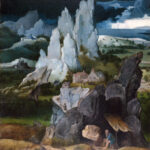
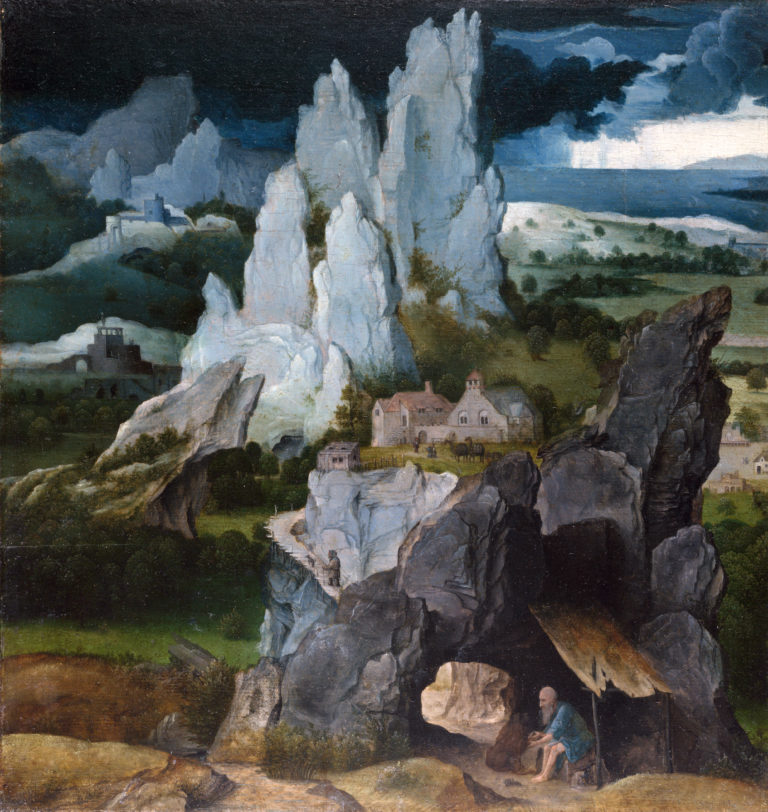
In November 2008, a symposium was held at the Centre d’études supérieures sur la Renaissance in Tours on the theme of « Contemplation in Flemish painting (14th-16th centuries) ».
Here is a transcript of the contribution by Karel Vereycken on Joachim Patinir, a little-known Belgian painter who is essential to the history of art.
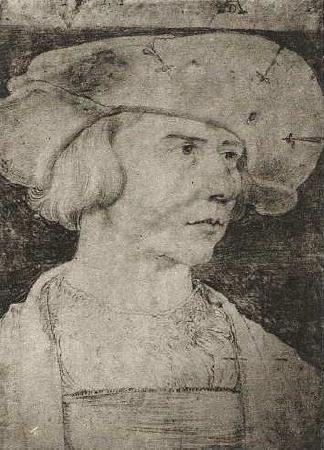
It is generally believed that the « modern » concept of landscape in Flemish painting only emerged with the work of Joachim Patinir (1485-1524), a Dinant-born painter working in Antwerp in the early 16th century.
For Viennese art historian Ludwig von Baldass (1887-1963), writing at the beginning of the 20th century, Patinir‘s work, presented as clearly ahead of its time, would herald landscape as überschauweltlandschaft, translatable as « panoramic landscape of the world », a truly cosmic and totalizing representation of the visible universe.
What characterizes Patinir‘s work, say the proponents of this analysis, is the sheer scale of the landscapes it presents for the viewer to contemplate.
This breadth has a dual character: the space depicted is immense (due to a panoramic viewpoint situated high up, almost « celestial »), while at the same time it encompasses, without concern for geographical verisimilitude, the greatest possible number of different phenomena and representative specimens, typical of what the earth can offer as curiosities, sometimes even imaginary, dreamlike, unreal, fantastic motifs: fields, woods, anthropomorphic mountains, villages and cities, deserts and forests, rainbows and storms, swamps and rivers, rivers and volcanoes.
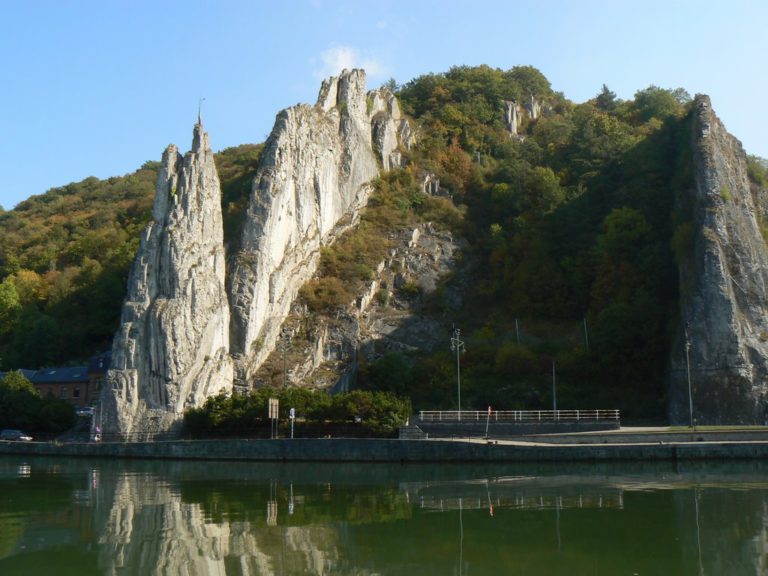
For example, the « Bayart Rock », which borders the Meuse not far from Patinir‘s native town of Dinant.
In addition to this panoramic perspective, Patinir uses aerial perspective – theorized at the time by Leonardo da Vinci – by dividing the space into three color planes: brown-ochre for the first plane, green for the middle plane and blue for the distant plane.
However, the painter preserves the visibility of the totality of details with a meticulousness, minutiae and preciousness worthy of the Flemish masters of the XVth century, who, by tending towards a quantitative infinity (consisting in showing everything), sought to approach a qualitative infinity (allowing us to see everything).
For their part, the authors of the weltlandschaft thesis, after showering with praise, do not hesitate to strongly relativize his contribution, saying:
« For landscape painting to become anything other than a virtuoso but compulsive accumulation of motifs, and more precisely, the quasi-documentary capture of an infinitesimal fragment of contingent reality, we have to wait for the XVIIth century and the full maturity of Dutch painting… ».
And it’s here that the trap of this approach, which consists in making us believe that the advent of landscape as an autonomous genre, its so-called « secularization », is simply the result of emancipation from a medieval and religious mental matrix, considered necessarily retrograde, for which landscape was reduced to a pure emanation or incarnation of divine power, is clearly identified.
Patinir, the first, would thus have demonstrated a purely « modern » aesthetic conception, and these « realistic » landscapes would mark the transition from a religious – and therefore obscurantist – cultural paradigm to a modern one, i.e. one devoid of meaning… which he would later be criticized for.
This is how the romantic and fantastic minds of the XVIIth and XVIIIth centuries viewed the artists of the XVth and XVIth centuries.
Von Baldass was undoubtedly influenced by the writings of Goethe, who, no doubt in a moment of enthusiasm for Greek paganism, analyzed the increasingly diminished role of religious figures in XVIth-century Flemish paintings and deduced that it was no longer the religious subject that was the subject, but the landscape.
Just as Rubens would have used the pretext of painting Adam and Eve expelled from Paradise to be able to paint nudes, Patinir would simply have seized the pretext of a biblical passage to be able to indulge his true passion, landscape…
A little detour via Hieronymus Bosch
A fresh look at Patinir’s work clearly demonstrates the error of this analysis.
To arrive at a more accurate reading, I suggest a detour to Hieronymus Bosch, whose spirit was very much alive among Erasmus‘ circle of friends in Antwerp (Gérard David, Quentin Massys, Jan Wellens Cock, Albrecht Dürer, etc.), of which Patinir was a member.
Bosch, contrary to the clichés still in vogue today, is above all a pious and moralizing spirit. If he shows vice, it’s not so much to praise it as to make us aware of just how much it attracts us. Faithful to the Augustinian traditions of Devotio Moderna, promoted by the Brothers of the Common Life (a spiritual renewal movement to which he was close), Bosch believes that man’s attachment to earthly things leads him to sin. This is the central theme of all his work, the spirit of which can only be penetrated by reading The Imitation of Christ, written, in all probability, by the founding soul of the Devotio Moderna, Geert Groote (1340-1384), or his disciple, Thomas à Kempis (1379-1471), to whom this work is generally attributed.
In this work, the most widely read in human history after the Bible, we read:
« Vanity of vanities, all is vanity, except loving God and serving Him alone.
Sovereign wisdom is to strive for the kingdom of heaven by despising the world.
—Vanity, then, to hoard perishable riches and hope in them.
—Vanity to aspire to honors and to rise to the highest.
—Vanity, to follow the desires of the flesh and seek that for which one must soon be rigorously punished.
—Vanity, to wish for a long life and not care about living well.
—Vanity, to think only of the present life and not to foresee what will follow it.
—Vanity, to cling to what passes so quickly and not hasten towards the joy that never ends.
Remember often the words of the wise man: the eye is not satisfied with what it sees, nor the ear with what it hears.
Apply yourselves, therefore, to detaching your heart from the love of visible things, to bring it entirely to the invisible ones, for those who follow the lure of their senses defile their souls and lose the grace of God. »
Bosch treats this subject with great compassion and humor in his painting The Hay Wagon (Prado Museum, Madrid).
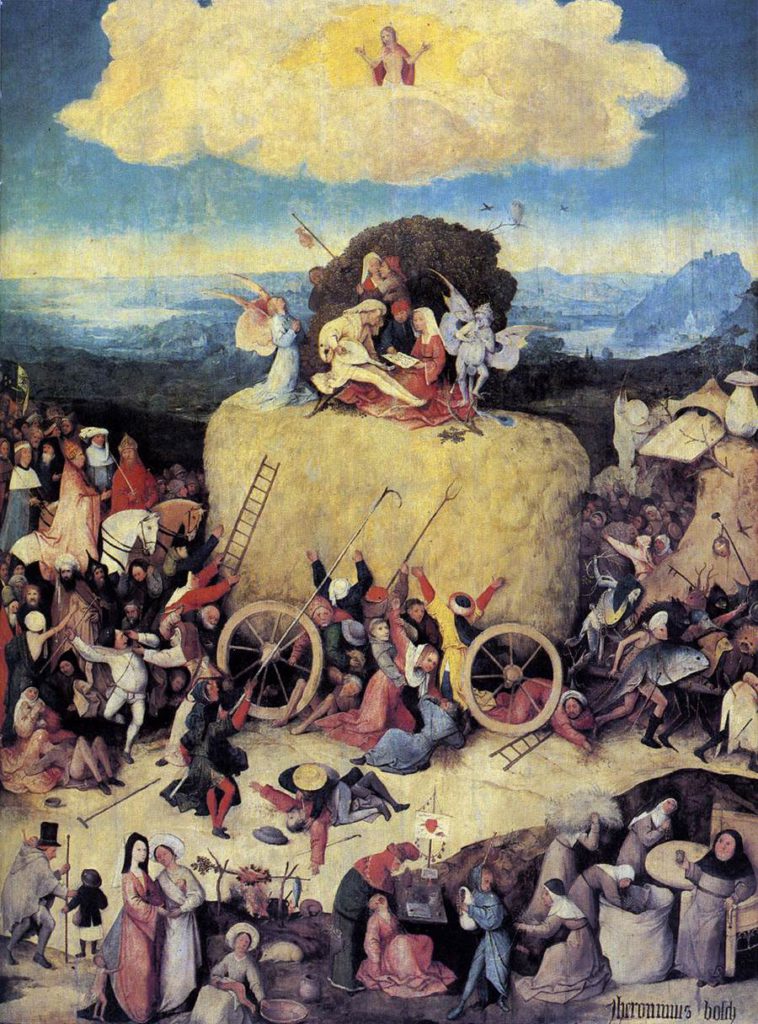
The allegory of straw already exists in the Old Testament. Isaiah 40:6 :
« All flesh is grass,
and all its brightness like the flower of the field;
The grass withers, the flower withers,
when the breath of Yahweh passes over it.
« Yes, the people are grass.
The grass withers, the flower withers,
but the word of our God
is fulfilled forever.«
It was echoed in the New Testament by the apostle Peter (1:24):
« For all flesh is like grass,
and all its glory like the flower of grass.
The grass withers,
and the flower falls. »
Johannes Brahms uses this passage in the second movement of his German Requiem.
Bosch‘s triptych depicts a hay wagon, an allegory of the vanity of earthly riches, pulled by strange creatures on their way to hell.
The Duke of Burgundy, the Emperor of Germany and even the Pope himself (this is the time of Julius II…) follow close behind, while a dozen or so characters fight to the death for a blade of straw. It’s a bit like the huge speculative securities bubble that is leading our era into a great depression…
It’s easy to imagine the bankers who sabotaged the G20 summit to perpetuate their system, which is so profitable in the very short term. But this corruption doesn’t just affect the big boys. In the foreground of the picture, an abbot has entire sacks of hay filled, a false dentist and also gypsies cheat people for a bit of straw.
The peddler and the Homo Viator
The closed triptych sums up the same topos in the form of a peddler (not the prodigal son). This peddler, eternal homo viator, is an allegory of Man who fights to stay on the right path and insists on staying on it.
In another version of the same subject painted by Bosch (Museum Boijmans Beuningen, Rotterdam), the peddler advances op een slof en een schoen (on a slipper and a shoe), i.e. he chooses precariousness, leaving the visible world of sin (we see a brothel and drunkards) and abandoning his material possessions.
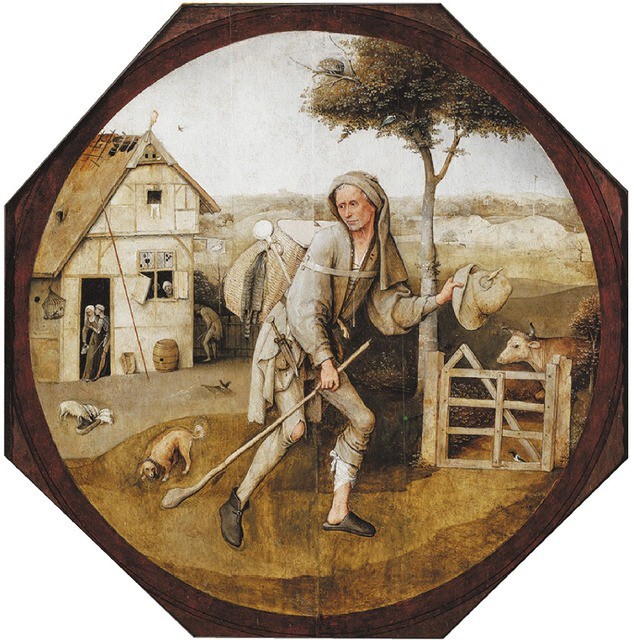
With his staff (symbol of faith), he fends off the infernal dogs (symbol of temptation), who try to hold him back.
Once again, these are not manifestations of Bosch‘s exuberant imagination, but of a metaphorical language common at the time. We find this representation in the margin of the famous Luttrell Psalter, a XIVth-century English psalter.
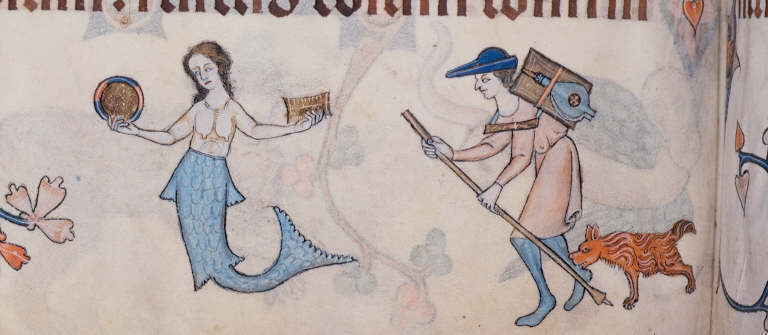
This theme of homo viator, the man who detaches himself from earthly goods, is also recurrent in the art and literature of this period, particularly since the Dutch translation of Pèlerinage de la vie et de l’âme humaine (pilgrimage of life and the human soul), written in 1358 by the Norman Cistercian monk Guillaume de Degulleville (1295-after 1358).
A miniature from this work shows a soul on its way, dressed as a peddler.
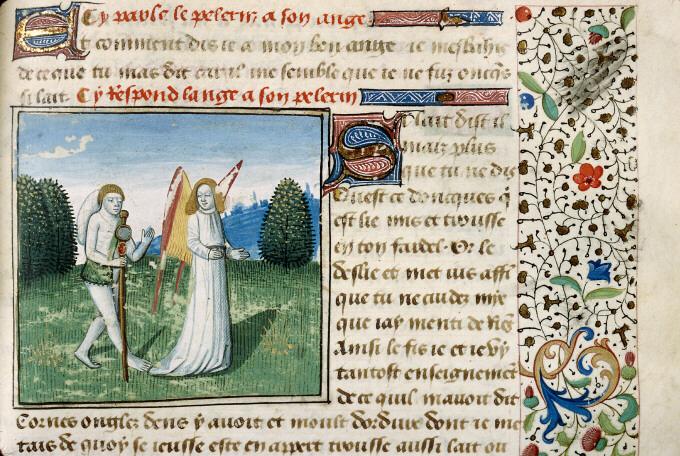
Nevertheless, while in the XIVth century this spiritual requirement may have dictated a sometimes excessive rigorism, the liberating laughter of nascent humanism (Brant, Erasmus, Rabelais, etc.) would bring happier, freer colors to Flemish Brabant culture (Bosch, Matsys, Bruegel), albeit later stifled by the dictates of the Council of Trent.
Man’s foolish attachment to earthly goods became a laughing matter. Published in Basel in 1494, Sébastien Brant’s Ship of Fools, a veritable inventory of all the follies that can lead man to his doom, left its mark on an entire generation, which rediscovered creativity and optimism thanks to the liberating laughter of Erasmus and his disciple, the Christian humanist François Rabelais.
In any case, for Bosch, Patinir and the Devotio Moderna, contemplation was the very opposite of pessimism and scholastic passivity. For them, laughter is the ideal antidote to despair, acedia (weariness) and melancholy.
Contemplation thus took on a new dimension. Each member of the faithful is encouraged to live out his or her Christian commitment, through personal experience and individual imitation of Christ. They must stop blaming themselves on the great figures of the Bible and Sacred History.
Man can no longer rely on the intercession of the Virgin Mary, the apostles and the saints. While following their examples, he must give personal content to the ideal of the Christian life. Driven to action, each individual, fully aware of his or her sinful nature, is constantly led to choose good over evil. These are just a few of the cultural backgrounds that enable us to approach Patinir’s landscapes in a different way.
Charon crossing the Styx
Patinir’s painting Charon Crossing the Styx (Prado Museum, Madrid), which combines ancient and Christian traditions, will serve here as our « Rosetta stone ». Inspired by the sixth book of the Aeneid, in which the Roman writer Virgil describes the catabasis, or descent into hell, or Dante‘s Inferno (3, line 78) taken from Virgil, Patinir places a boat at the center of the work.
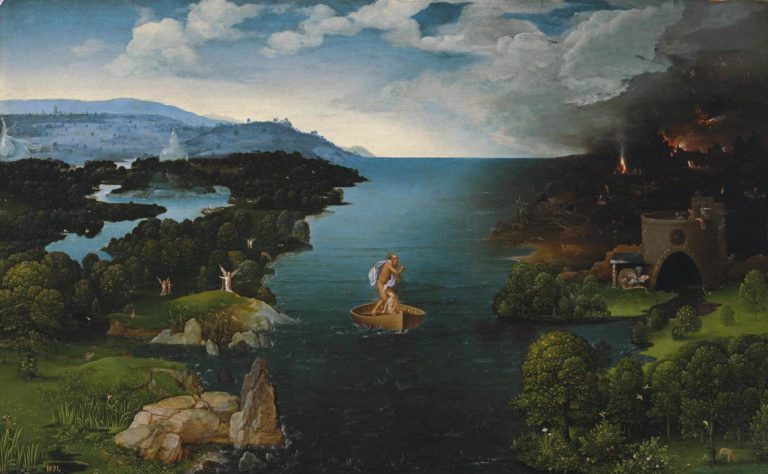
The tall figure standing in this boat is Charon, the Ferryman of the Underworld, usually portrayed as a gloomy, sinister old man. His task is to ferry the souls of the deceased across the River Styx.
In payment, Charon takes a coin placed in the mouths of the corpses. The passenger in the boat is thus a human soul.
Although the scene takes place after the person’s physical death, the soul – and this may come as a surprise – is tormented by the choice between Heaven and Hell.
Since the Council of Trent, it has been considered that a bad life irrevocably sends man to Hell from the moment of his death. But Christian faith continues, even today, to distinguish the Last Judgment from what is known as the « particular judgment ».
According to this concept, which is sometimes disputed within denominations, at the moment of death, although our final fate is fixed (Hebrews 9:27), all the consequences of this particular Judgment will not be drawn until the general Judgment, which will take place when Christ returns at the end of time.
So, the « particular judgment » that is supposed to immediately follow our death, concerns our last act of freedom, prepared by all that our life has been. Helping us to contemplate this ultimate moment therefore seems to be the primary aim of Patinir‘s painting, with other metaphors thrown in for good measure.
However, a closer look at the lower part of the painting reveals a contradiction that is absent from Virgil’s poem. While Hell is on the right (Cerberus, the three-headed dog guarding the gateway to Hell, can be seen), the gateway seems easily accessible, with splendid trees dotting the lawns.
To the left is Paradise. An angel tries to attract the attention of the soul in the boat, but it seems much more attracted by a seemingly welcoming Hell.
What’s more, the dimly-lit path to paradise seems perilous, with rocks, swamps and other dangerous obstacles. Once again, it’s our senses that may lead us to make a literally hellish choice.
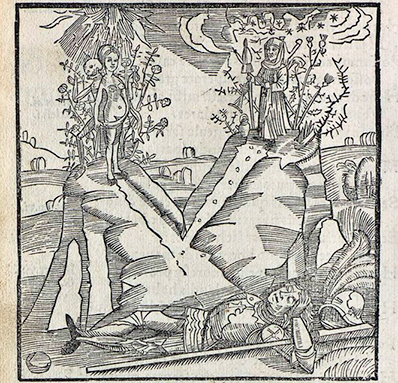
The subject of the painting is clearly that of the bivium, the binary choice at the crossroads that offers the pilgrim viewer the choice between the path of vice and that of salvation.
This theme was widespread at the time. We find it again in Sébastien Brant‘s Ship of Fools, in the form of Hercules at the crossroads. In this illustration, on the left, at the top of a hill, a naked woman represents vice and idleness. Behind her, death smiles down on us.
On the right, planted at the top of a higher hill, at the end of a rocky path, awaits virtue symbolized by work. Let’s also remember that the Gospel (Matthew 7:13-14) clearly evokes the choice we will face:
« Enter by the narrow gate.
For wide is the gate and broad is the road that leads to destruction,
and there are many who enter by it.
But the gate is narrow and the way to life is narrow,
and there are few who find it ».
Landscape as an object of contemplation
The art historian Reindert Leonard Falkenburg, in his 1985 doctoral thesis, was the first to note that Patinir takes pleasure in transposing this metaphorical language to the whole of his landscape.
Although the image of impassable rocks as a metaphor for the virtue achieved by choosing the difficult path is nothing new, Patinir exploits this idea with unprecedented virtuosity.
We thus discover that the theme of man courageously turning away from the temptation of a world that traps our sensorium, is the underlying theo-philosophical theme of almost all Patinir’s landscapes. In this way, his work finds its raison d’être as an object of contemplation, where man measures himself against the infinite.Let’s return to our Landscape with Saint Jerome by Patinir (National Gallery, London).
Here we discover the « narrow gate » leading to a difficult path that takes us to the first plateau. This is not the highest mountain. The highest, like the Tower of Babylon, is a symbol of pride.
Next, let’s look at Resting on the Road to Egypt (Prado Museum, Madrid). At the side of the road, Mary is seated, and in front of her, on the ground, are the peddler’s staff and his typical basket.
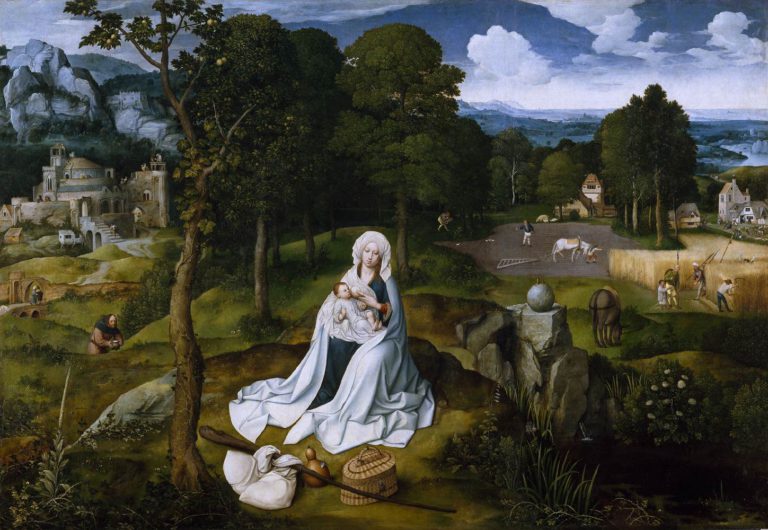
In conclusion, we could say that, driven by his spiritual and humanist fervor, by painting increasingly impassable rocks – reflecting the immense virtue of those who decide to climb them – Patinir elaborates not « realistic » landscapes, but « spiritual landscapes », dictated by the immense need to tell the spiritual journey of the soul.
Hence, far from being mere aesthetic objects, his spiritual landscapes serve contemplation.
Like a half-ironic mirror image, they enable those who wish to do so to prepare for the choices their soul will face during, and after, life’s pilgrimage.
Bibliography:
- R.L. Falkenburg, Joachim Patinir, Het landschap als beeld van de levenspelgrimage, Nijmegen, 1985;
- Maurice Pons and André Barret, Patinir ou l’harmonie du monde, Robert Laffont, 1980;
- Eric de Bruyn, De vergeten beeldentaal van Jheronimus Bosch, Adr. Heinen, s’Hertogenbosch, 2001;
- Dirk Bax, Hieronymus Bosch, his picture-writing deciphered, A. A. Balkema, Capetown, 1979;
- Georgette Epinay-Burgard, Gérard Groote, fondateur de la Dévotion Moderne, Brepols, 1998.
- Karel Vereycken, Devotio Moderna, cradle of Humanism in the North, Artkarel.com, 2011;
- Karel Vereycken, With Hieronymus Bosch on the track of the Sublime, Schiller Institute, 2007.
- Karel Vereycken, How Erasmus Folly saved our Civilization, Schiller Institute, 2004.
Posted in Comprendre, Etudes Renaissance | Commentaires fermés sur Joachim Patinir and the invention of landscape painting
Tags: Antwerp, artkarel, Barret, Bax, bible, bivium, Bosch, brabant, Brahms, Brant, Brothers of the Common Life, Bruegel, Burgundy, Charon, Christ, Christian, commitment, contemplation, Council of Trent, crossroads, Dante, Degulleville, Devotio Moderna, Egypt, Epinay-Burgard, Erasme, Eric de Bruyn, Falkenburg, Germany, Groote, Hercules, Hieronymus, Homo Viator, invention of landscape, irony, Julius II, Karel, Karel Vereycken, landscape, Lutrell Psalter, Matsys, Netherlands, Patinir, peddler, peinture, Pons, Pope, prodigal son, Rabelais, realism, renaissance, Requiem, Sacred History, Ship of Fools, Soul, spirituality, Styx, Vereycken, Virgil, Wellens Cock